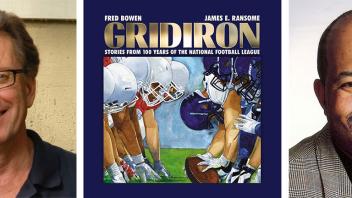Sports are important to young people on many levels. When participating, they experience teamwork, self-discipline, following rules, and just plain fun. Often, children see role models in professional athletes.
But professional sports can provide an introduction to history, depicting the times in which they are played. Also like the world we live in, games have evolved over time to respond to events and social changes.
A collaboration by two sports aficionados, author Fred Bowen and illustrator James Ransome, Gridiron: Stories from 100 Years of the National Football League (McElderry), is a handsome look at the sport, its history, game strategies, all presented in detailed, intriguing stories.
Fred and James have agreed to answer some questions about this collaboration and their book.
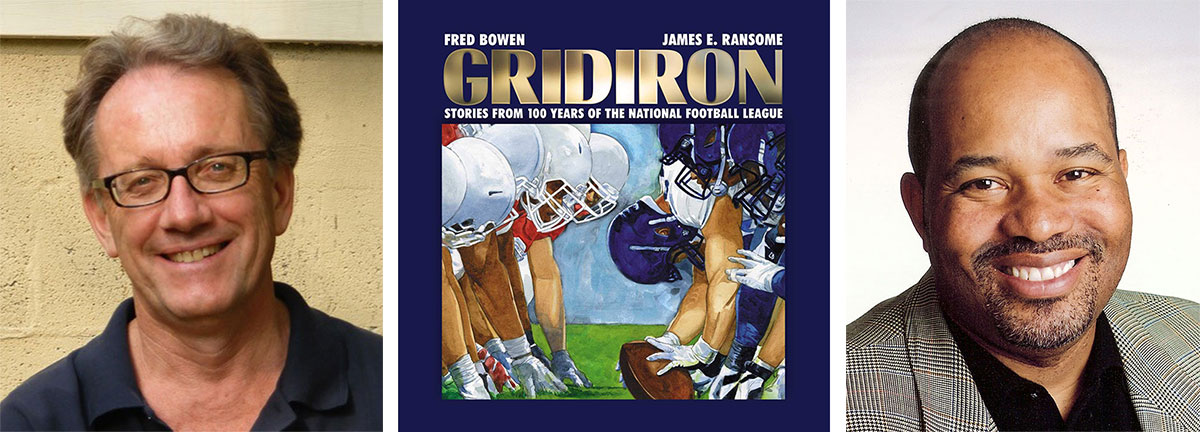
(Fred Bowen, left, and James Ransome, right.)
Fred and James, when did you first become interested in sports? How did your early experiences influence your obvious passion as adults?
Fred: I grew up in a big (7 kids) family in Massachusetts. We all played games and sports. There were “house championships” at everything from badminton to races around the house to free throw shooting in basketball. In fact, I still compete for a family championship with my siblings as well as my nephews and nieces in golf.
My family also watched sports on television. Some of my earliest memories were of watching the New York Giants play football games on Sunday afternoon. I am sure these memories of playing and watching games as well as the warm feelings of being with my family fueled my interest in sports.
James: I grew up with my grandmother who had no interest in sports. So, my interest in sports came from fellow classmates, books and television. In 1972, a few of my friends were discussing the Superbowl, that had been on television the night before. When I asked them who won, they told me it was the Miami Dolphins. I remember thinking what a cool team name that was. It evoked images of palm trees and beaches and in that moment I became a lifelong Dolphin fan. The following football season, I watched games. I listened closely to commentators to better understand the game and began to fall in love with the sport. Basketball and baseball were pretty easy to grasp, and I secretly held out hope that I could one day join the Harlem Globetrotters.
What I learned as a kid is that unlike religion, politics and social issues, sports is one of the safest topics people can discuss. Even if I strongly dislike a team or my team is doing poorly, I can still enjoy a rivalry with friends and fans.
How did you guys come together to create Gridiron …? Isn’t it unusual for an author and illustrator to collaborate during the creative process?
James: It was probably five to six years ago I started thinking about the upcoming 100th anniversary of the NFL and because I am looking for opportunities to create images around topics I am interested in, the anniversary seemed like a perfect way to combine history, sports and my own passions. I begin researching the history with the idea that I would write and illustrate the book. After juggling deadlines for other book projects, traveling, and teaching, I realized years had passed and I still hadn’t found the time to write one sentence let alone a book. That’s when I realized I’d need help.
I met Fred and saw his books at a conference in Maryland. Right away I knew he’d be the perfect person to write for the manuscript. I shared only my overall vision for the project and then Fred sent me a first draft of a sample chapter. I did emphasize that I wanted to be sure the text reflected the fast pace and dramatic moments of the game and Fred incorporated those elements into the text.
Fred: The book was James’s idea. We met at a conference about five or six years ago where we were on a large author/illustrator panel together. I spoke about my Fred Bowen Sports Story books with Peachtree Publishers that combine sports fiction and sports history, and always have a chapter of sports history in the back. I also mentioned my weekly kids sports column that I have written for The Washington Post since April 2000. Many of those columns touch upon sports history.
After the panel was finished, James approached me and told me about his idea of doing a book on the history of the National Football League in time for the league’s centennial in 2020. He said he thought I was the guy who could write the book.
I was delighted at the thought of working with James because I have admired his art and books for years. So I was easy to convince.
From Pre-Game Show to Post-Game Show with four quarters in between, the organization of the book is intriguing. Why and how did you decide to do this?
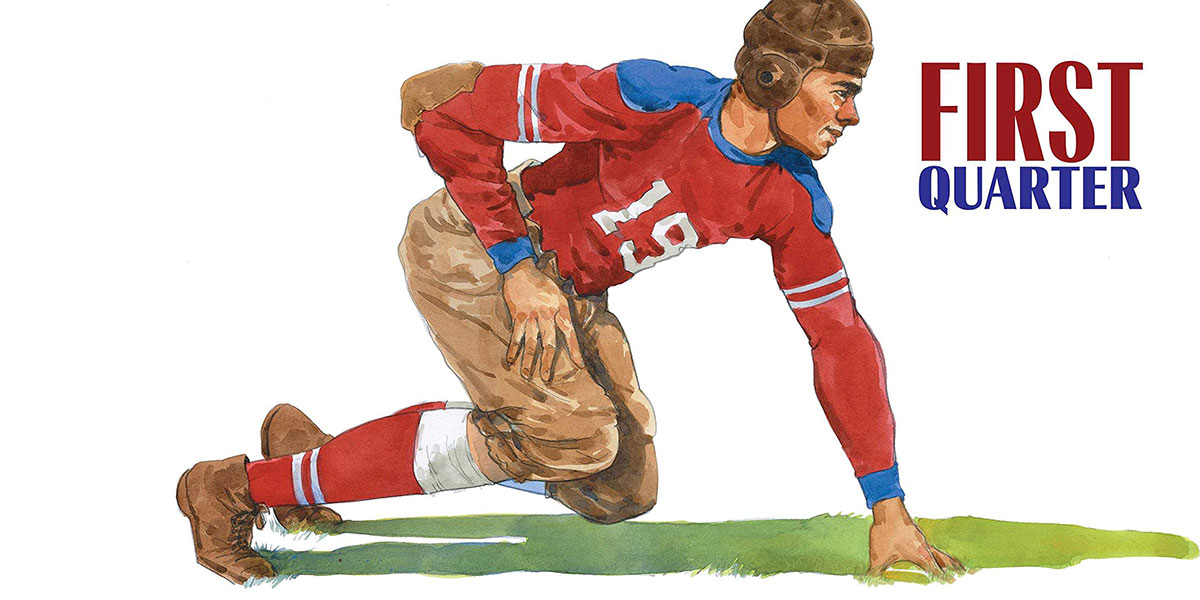
Fred: The division of the book into four quarters was another one of James’s ideas. It really helped with the organization of the writing. Looking back, this forced me to spread the topics of the chapters over the entire 100-year history of the NFL. I don’t think the book would work as well if we had half of the chapters about the very early days of the league or if most of the chapters were about recent games and players.
I also love James’s illustrations at the beginning of each quarter of a typical football player from the era. These illustrations give our young readers a sense of how the game has changed over the years.
James: Aside from our initial discussion, it was Fred who organized the chapters in the way that made sense to him as a writer.
There is fascinating historical detail in the stories you share. How did you do the research for the narrative? For the illustration? Particularly the early days of football?
James: I purchased a ton of books on the history of football and also watched a lot of old games on YouTube.
Fred: I read a lot of books about the NFL! I also read lots of articles about the league. My editor actually asked me to shorten the bibliography in the back of the book because we were running out of space.
Something that is interesting about the research for a project such as Gridiron is that you may read a whole book to get one or two interesting facts about a particular topic. So you end up reading much more material than you actually use.
World War II had a huge impact on the game. Talk about that, Fred.
Fred: The first impact was so many players served in the military during America’s participation in World War II (1941 to 1945). More than 600 NFL players served in the armed forces and 20 died.
The amount of football talent in the NFL dropped so drastically during the war years that some teams had to merge to have enough players to play games. One team, the Cleveland Rams, suspended operations entirely for the 1943 season. Teams were so desperate they would take almost anyone to fill out their rosters.
But in a strange way World War II helped the NFL. After the war, hundreds of players returned hoping to continue their playing careers. In addition, players were coming out of college during the later years of the war and thinking of playing in the NFL. Finally, the NFL began to allow African-Americans to play after banning them for 12 years (1932 to 1946).
So in the years following World War II there was a huge influx of talent into the league. Play improved and the games became more exciting. This set the stage for the NFL to become more popular in later years.
The weather, too, has an impact. The 1967 Ice Bowl was a particularly chilling game. James, your illustrations made me cold just looking at them. What kind of photographic research did you do to achieve that?
James: I found two photos but I thought they didn’t have the impact that I was looking for. So, I zoomed in, the art term is bringing the image to the surface and cropping off the figures on all sides, to give the feeling that the composition can’t contain the action. The fun part was drawing in people wearing big coats, face masks and finally adding the steam coming from the fans with pastels.
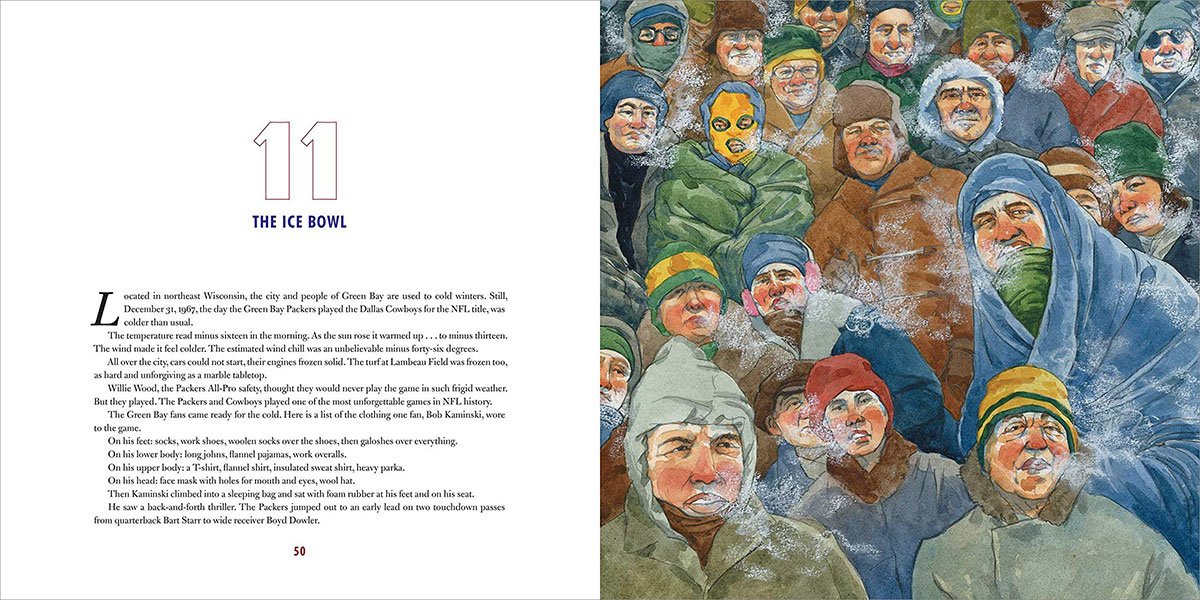
Fred, how did you find the fascinating details (for example, what one man who attended wore in game time temperatures). The overall effect is to make the reader feel the cold!
Fred: I believe I found that description in David Maraniss’s wonderful biography of Vince Lombardi, When Pride Still Mattered (Simon & Schuster). I also found some other details about the famous “Ice Bowl” game between the Dallas Cowboys and Green Bay Packers in Jerry Kramer’s book, Instant Replay (Anchor). Kramer, of course, played in the game and made the block that allowed Bart Starr to score the winning touchdown.
One detail of the “Ice Bowl” game I wasn’t able to fit in was the story that during the game Frank Gifford, one of the game’s announcers, said, “Excuse me while I take another bite of my coffee.”
James’s illustration of the crowd at the game is one of my (many) favorites in the book. The people in the painting really look cold! They had to be rabid football fans. Or a little crazy. Or both.
There must be many more stories and interesting pieces that you had to leave out. How did you decide what stories to include and which to omit?
Fred: Definitely. In fact, I dedicated a column in The Washington Post “KidsPost” one week to all the stories I could not fit into the book. Those stories included:
- The Hammond Pros did not score a single point during its (6-game) 1922 season.
- The Duluth Eskimos played only one home game during their 1926 and 1927 seasons. That’s 22 games on the road.
- During the first night NFL game, they painted the football white so the players could see it better.
- Byron “Whizzer” White led the NFL in rushing two seasons (1938 and 1940). He later became a Supreme Court Justice.
- Helmets were not required in the NFL until 1943.
- The term “taxi squad” came about because Paul Brown would get his extra Cleveland players jobs with local taxicab companies.
There were many more stories I couldn’t fit in the book or the column. The NFL has a rich history.
You list top receivers and rushers. As the game changed, however, other positions became more and more important. Why did you focus on these positions?
Fred: I’m not sure whose idea it was to include lists of the leading runners and receivers. But I think it was a terrific way to get more names of great players in the book. For example, Larry Fitzgerald and Marvin Harrison may not have been “historical” figures in the same way as Jerry Rice or Don Hutson, but they were great wide receivers. It is wonderful to have them in the book. It is the same with running backs such as Tony Dorsett and Marcus Allen.
Also, sports fans, and especially kids, love lists of leading players as well as statistics. The lists are ways to get those things into the book.
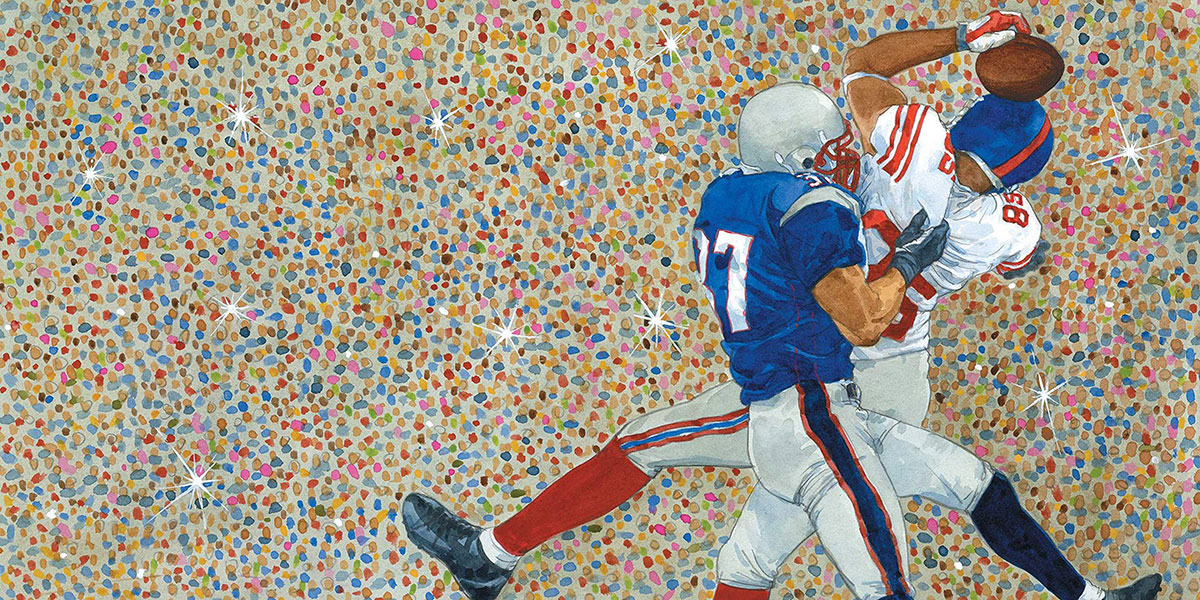
How did you narrow down the sources used? Why is the back matter important?
Fred: That is a problem with a project like Gridiron. The research is so much fun that it is easy to keep researching the old days of the NFL. But at some point you have to sit down and tell the stories and do the writing. Luckily, I enjoy writing too. It was fun to organize and write the chapters in the book. I think the back matter in the book — the 18 portraits of famous NFL coaches and players as well as the short write-ups about them — was another way to get more names and faces into the book.
And especially more contemporary players. So often when I mentioned the book to friends as I was working on the project, they would say, “You have to write about Peyton Manning” or some other favorite players of theirs. You can’t include everyone’s favorites in the book so it is good to have a way to give more players their due. Of course, I think it was also a way for James to get in some of his favorite players!
Many thanks to Fred and James for taking time to provide a brief, insider’s look at this gorgeous and totally fascinating look at a sport that continues to evolve.
Together text and illustration present a portrait of American history that will surely engage young athletes and non-athletes alike!
About the Author
Reading Rockets’ children’s literature expert, Maria Salvadore, brings you into her world as she explores the best ways to use kids’ books both inside — and outside — of the classroom.
